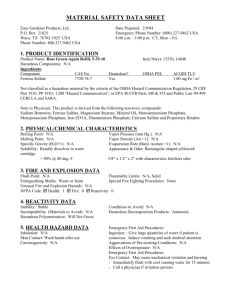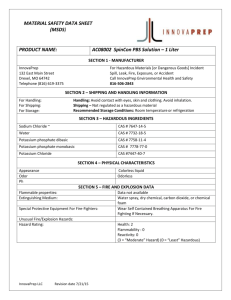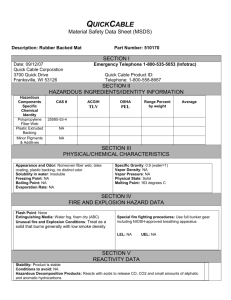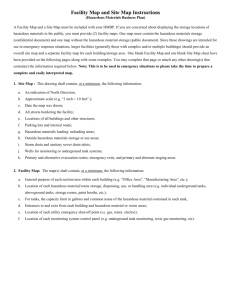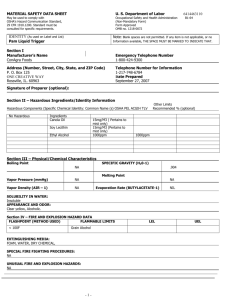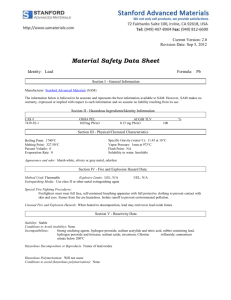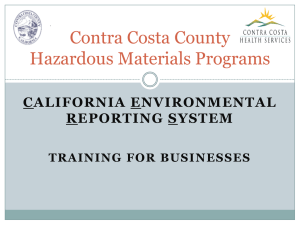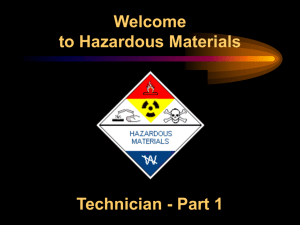Medium and High-Expansion Foam Systems
advertisement
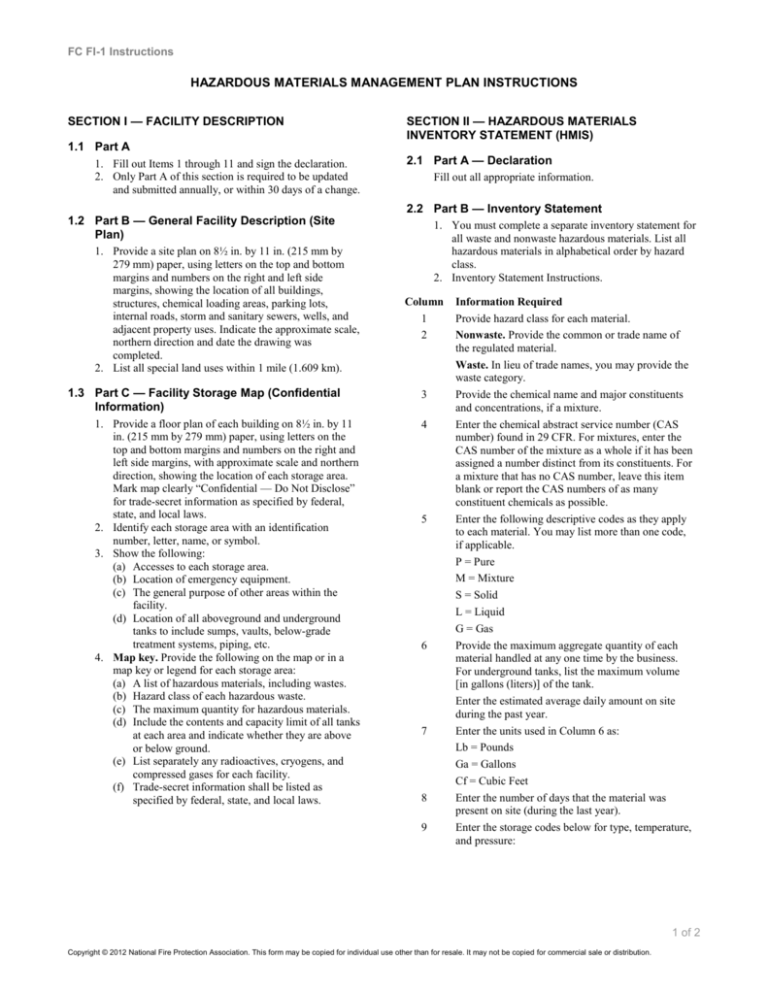
FC FI-1 Instructions HAZARDOUS MATERIALS MANAGEMENT PLAN INSTRUCTIONS SECTION I — FACILITY DESCRIPTION SECTION II — HAZARDOUS MATERIALS INVENTORY STATEMENT (HMIS) 1.1 Part A 1. Fill out Items 1 through 11 and sign the declaration. 2. Only Part A of this section is required to be updated and submitted annually, or within 30 days of a change. 1.2 Part B — General Facility Description (Site Plan) 1. Provide a site plan on 8½ in. by 11 in. (215 mm by 279 mm) paper, using letters on the top and bottom margins and numbers on the right and left side margins, showing the location of all buildings, structures, chemical loading areas, parking lots, internal roads, storm and sanitary sewers, wells, and adjacent property uses. Indicate the approximate scale, northern direction and date the drawing was completed. 2. List all special land uses within 1 mile (1.609 km). 1.3 Part C — Facility Storage Map (Confidential Information) 1. Provide a floor plan of each building on 8½ in. by 11 in. (215 mm by 279 mm) paper, using letters on the top and bottom margins and numbers on the right and left side margins, with approximate scale and northern direction, showing the location of each storage area. Mark map clearly “Confidential — Do Not Disclose” for trade-secret information as specified by federal, state, and local laws. 2. Identify each storage area with an identification number, letter, name, or symbol. 3. Show the following: (a) Accesses to each storage area. (b) Location of emergency equipment. (c) The general purpose of other areas within the facility. (d) Location of all aboveground and underground tanks to include sumps, vaults, below-grade treatment systems, piping, etc. 4. Map key. Provide the following on the map or in a map key or legend for each storage area: (a) A list of hazardous materials, including wastes. (b) Hazard class of each hazardous waste. (c) The maximum quantity for hazardous materials. (d) Include the contents and capacity limit of all tanks at each area and indicate whether they are above or below ground. (e) List separately any radioactives, cryogens, and compressed gases for each facility. (f) Trade-secret information shall be listed as specified by federal, state, and local laws. 2.1 Part A — Declaration Fill out all appropriate information. 2.2 Part B — Inventory Statement 1. You must complete a separate inventory statement for all waste and nonwaste hazardous materials. List all hazardous materials in alphabetical order by hazard class. 2. Inventory Statement Instructions. Column 1 2 3 4 5 6 7 8 9 Information Required Provide hazard class for each material. Nonwaste. Provide the common or trade name of the regulated material. Waste. In lieu of trade names, you may provide the waste category. Provide the chemical name and major constituents and concentrations, if a mixture. Enter the chemical abstract service number (CAS number) found in 29 CFR. For mixtures, enter the CAS number of the mixture as a whole if it has been assigned a number distinct from its constituents. For a mixture that has no CAS number, leave this item blank or report the CAS numbers of as many constituent chemicals as possible. Enter the following descriptive codes as they apply to each material. You may list more than one code, if applicable. P = Pure M = Mixture S = Solid L = Liquid G = Gas Provide the maximum aggregate quantity of each material handled at any one time by the business. For underground tanks, list the maximum volume [in gallons (liters)] of the tank. Enter the estimated average daily amount on site during the past year. Enter the units used in Column 6 as: Lb = Pounds Ga = Gallons Cf = Cubic Feet Enter the number of days that the material was present on site (during the last year). Enter the storage codes below for type, temperature, and pressure: 1 of 2 Copyright © 2012 National Fire Protection Association. This form may be copied for individual use other than for resale. It may not be copied for commercial sale or distribution. FC FI-1 Instructions Type A = Aboveground Tank B = Belowground Tank C = Tank Inside Building D = Steel Drum E = Plastic or Nonmetallic Drum F = Can G = Carboy H = Silo I = Fiber Drum J = Bag K = Box L = Cylinder M = Glass Bottle or Jug N = Plastic Bottles or Jugs O = Tote Bin P = Tank Wagon Q = Rail Car R = Other Temperature 4 = Ambient 5 = Greater than Ambient 6 = Less than Ambient, but not Cryogenic [less than –150°F (–101.1°C)] 7 = Cryogenic conditions [less than –150°F (–101.1°C)] 10 Pressure 1 = Ambient (Atmospheric) 2 = Greater than Ambient (Atmospheric) 3 = Less than Ambient (Atmospheric) For each material listed, provide the SARA Title III hazard class as listed below. You may list more than one class. These categories are defined in 40 CFR 370.3. Physical Hazard F = Fire P = Sudden Release of Pressure R = Reactivity 11 Health Hazard I = Immediate (Acute) D = Delayed (Chronic) Waste Only. For each waste, provide the total estimated amount of hazardous waste handled throughout the course of the year. SECTION III — SEPARATION AND MONITORING 3.1 Part A — Aboveground Fill out Items 1 through 6, or provide similar information for each storage area shown on the facility map. Use additional sheets as necessary. 3.2 Part B — Underground 1. Complete a separate page for each underground tank, sump, vault, below grade treatment system, etc. 2. Check the type of tank and method(s) that applies to your tank(s) and piping, and answer the appropriate questions. Provide any additional information in the space provided or on a separate sheet. SECTION IV — WASTE DISPOSAL Check all that apply and list the associated wastes for each method checked. SECTION V — RECORD KEEPING Include a brief description of your inspection procedures. You are also required to keep an inspection log and recordable discharge log, which are designed to be used in conjunction with routine inspections for all storage facilities or areas. Place a check in each box that describes your forms. If you do not use the sample forms, provide copies of your forms for review and approval. SECTION VI — EMERGENCY RESPONSE PLAN 1. This plan should describe the personnel, procedures, and equipment available for responding to a release or threatened release of hazardous materials that are stored, handled, or used on site. 2. A check or a response under each item indicates that a specific procedure is followed at the facility, or that the equipment specified is maintained on site. 3. If the facility maintains a more detailed emergency response plan on site, indicate this in Item 5. This plan shall be made available for review by the inspecting jurisdiction. SECTION VII — EMERGENCY RESPONSE TRAINING PLAN 1. This plan should describe the basic training plan used at the facility. 2. A check in the appropriate box indicates the training is provided or the records are maintained. 3. If the facility maintains a more detailed emergency response training plan, indicate this in Item 4. This plan shall be made available for review by the inspecting jurisdiction. 2 of 2 Copyright © 2012 National Fire Protection Association. This form may be copied for individual use other than for resale. It may not be copied for commercial sale or distribution.

